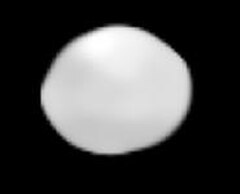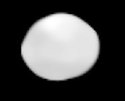(31) Euphrosyne
 Obraz uzyskany przez Very Large Telescope | |
| Odkrywca | |
|---|---|
| Data odkrycia | 1 września 1854 |
| Numer kolejny | 31 |
| Charakterystyka orbity (J2000) | |
| Przynależność obiektu | |
| Półoś wielka | 3,1491 au |
| Mimośród | 0,2251 |
| Peryhelium | 2,4404 au |
| Aphelium | 3,8579 au |
| Okres obiegu wokół Słońca | 5 lat 215 dni |
| Średnia prędkość | 16,57 km/s |
| Inklinacja | 26,31° |
| Charakterystyka fizyczna | |
| Średnica | 255,9 km |
| Masa | ~1,69 × 1019 kg |
| Średnia gęstość | ~1,9 g/cm3 |
| Okres obrotu | (5 h 31 min 52 s) h |
| Albedo | 0,05 |
| Jasność absolutna | 6,74m |
| Typ spektralny | |
| Średnia temperatura powierzchni | ~159 K |
(31) Euphrosyne – planetoida z pasa głównego planetoid okrążająca Słońce w ciągu 5 lat i 215 dni w średniej odległości 3,15 au.

Została odkryta 1 września 1854 roku w Waszyngtonie przez Jamesa Fergusona. Była to pierwsza planetoida odkryta w Ameryce Północnej. Nazwa planetoidy pochodzi od Eufrosyne, jednej z charyt w mitologii greckiej.
Zobacz też
Bibliografia
- (31) Euphrosyne w bazie Jet Propulsion Laboratory (ang.)
- (31) Euphrosyne w bazie Minor Planet Center (ang.)
Linki zewnętrzne
- Diagram orbity (31) Euphrosyne w bazie Jet Propulsion Laboratory (ang.)
Media użyte na tej stronie
Autor: VSO Very Large Telescope SPHERE/ZIMPOL team, Licencja: CC BY-SA 4.0
VLT/SPHERE image of the asteroid, deconvolved with the MISTRAL algorithm
August 3, 2015
Asteroid Euphrosyne as Seen by WISE on May 17, 2010
http://www.jpl.nasa.gov/spaceimages/details.php?id=pia19645
http://www.jpl.nasa.gov/news/news.php?feature=4678
The asteroid Euphrosyne glides across a field of background stars in this time-lapse view from NASA's WISE spacecraft. Euphrosyne is quite dark in visible light, but glows brightly at infrared wavelengths.
The asteroid Euphrosyne glides across a field of background stars in this time-lapse view from NASA's WISE spacecraft. WISE obtained the images used to create this view over a period of about a day around May 17, 2010, during which it observed the asteroid four times.
Because WISE (renamed NEOWISE in 2013) is an infrared telescope, it senses heat from asteroids. Euphrosyne is quite dark in visible light, but glows brightly at infrared wavelengths.
This view is a composite of images taken at four different infrared wavelengths: 3.4 microns (color-coded blue), 4.6 microns (cyan), 12 microns (green) and 22 microns (red).
The moving asteroid appears as a string of red dots because it is much cooler than the distant background stars. Stars have temperatures in the thousands of degrees, but the asteroid is cooler than room temperature. Thus the stars are represented by shorter wavelength (hotter) blue colors in this view, while the asteroid is shown in longer wavelength (cooler) reddish colors.
The WISE spacecraft was put into hibernation in 2011 upon completing its goal of surveying the entire sky in infrared light. WISE cataloged three quarters of a billion objects, including asteroids, stars and galaxies. In August 2013, NASA decided to reinstate the spacecraft on a mission to find and characterize more asteroids.
JPL manages NEOWISE for NASA's Science Mission Directorate at the agency's headquarters in Washington. The Space Dynamics Laboratory in Logan, Utah, built the science instrument. Ball Aerospace & Technologies Corp. of Boulder, Colorado, built the spacecraft. Science operations and data processing take place at the Infrared Processing and Analysis Center at the California Institute of Technology in Pasadena. Caltech manages JPL for NASA.
More information is online at http://www.nasa.gov/wise, http://wise.astro.ucla.edu and http://www.jpl.nasa.gov/wise.
